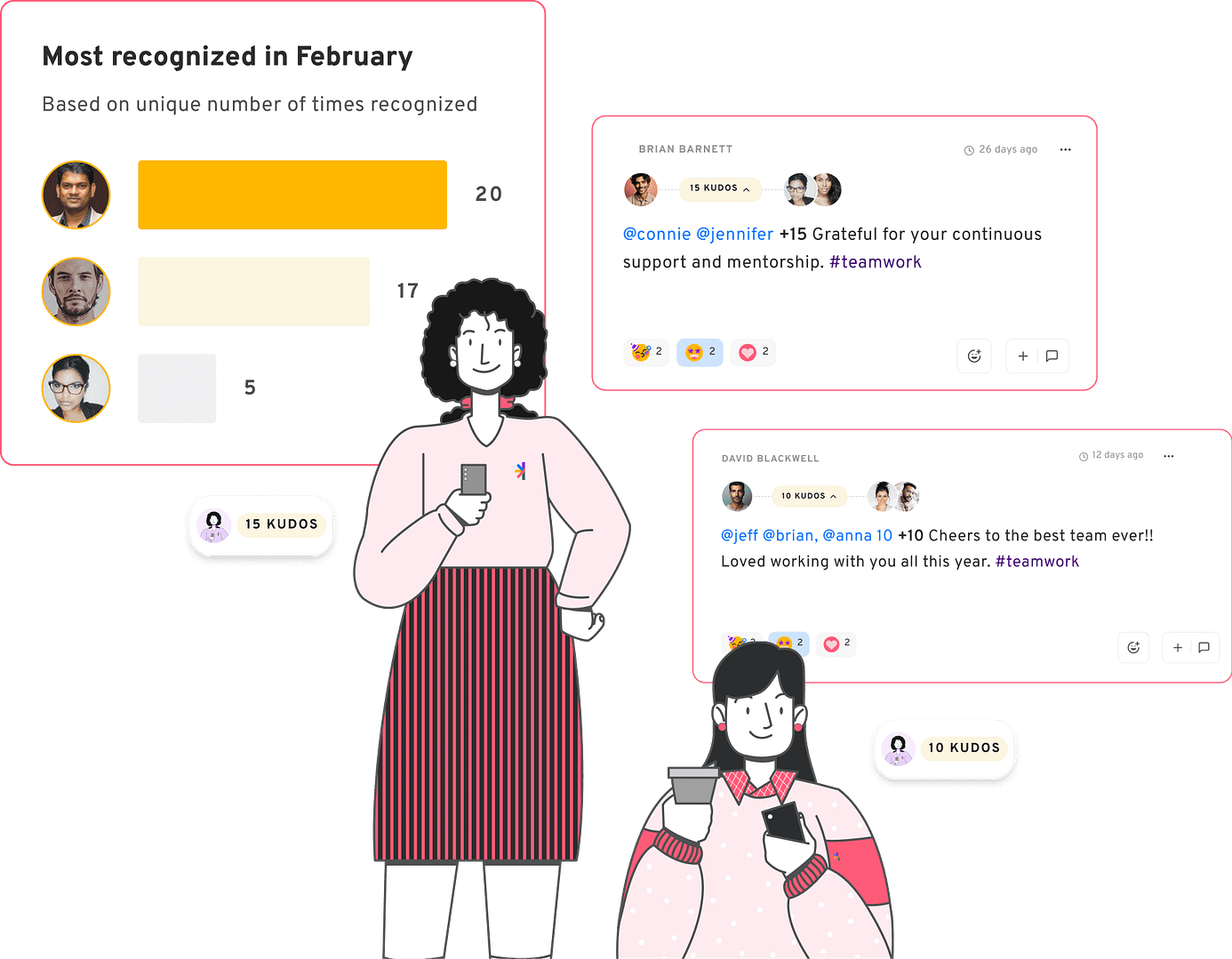Employee recognition
Employee Recognition Program Proposal: Leaders Guide
A comprehensive employee recognition program proposal that empowers leaders to boost team morale, retention, and engagement through effective recognition strategies.
Explore Stadium's recognition program that enables 360 degree recognition with 1m+ rewards.

Employees don’t leave corporations; they tend to leave their bosses who do not appreciate their efforts.
This guide focuses on how to make a difference in your team’s life as a leader. Too many talented employees leave simply due to a lack of appreciation.
The worst part of this situation is that appreciation does not incur costs but increases returns.
The proposal describes methods of appreciation that are useful and significant. There is no fluff, just steps that help you achieve your goal.
When employees are recognized and appreciated, their hard work tends to increase, as well as their willingness to go above and beyond.
What is the impact?
A positive attitude improves people’s morale, workplace satisfaction, and productivity and improves the effort put into a positive company culture.
Table of Contents

What is an Employee Recognition Program Proposal?
Consider an employee recognition program as your strategy to highlight and reward productive work.
It’s not just service awards or employee of the month.
A program like this outlines and equips leaders at all levels with strategies to appreciate efforts and contributions, ranging from informal “thank you” after intense projects to more official remembrance and appreciation during milestones.
When employees feel appreciated genuinely, we have observed engagement levels increasing; retention issues, on the other hand, start disappearing.
The most effective programs offer various avenues for recognition, from informal peer acknowledgment to official commendation from superiors.
Steps for pitching employee recognition to your executive team
Initiating an employee recognition program requires obtaining executive team approval because it represents any other HR initiative.
You must create an attractive business argument describing how employee recognition practices generate clear business measurement indicators.
When making your presentation, focus on linking recognition directly to employee retention and productivity alongside improved satisfaction rates because executives understand financial metrics and returns on investment.
Prepare answers to address executive team queries regarding the price of implementation and duration and real examples from established recognition programs implemented elsewhere.

1. Write a Problem Statement
You should begin by choosing particular organizational difficulties that recognition strategies can successfully tackle.
Exit interviews show that employees do not perceive the organization as appreciating them.
Do particular sections within the organization show declining employee engagement?
Real figures should demonstrate existing deficiencies in your company’s cultural environment. You should stress that employee appreciation costs the company productivity and talent retention through inadequate organized programs.
Your problem statement will make executives understand the critical need to accept your recognition program proposal immediately.
2. Outline Your Approach to Recognition
Your recognition program must provide a visible framework incorporating multiple ways to recognize employee achievements.
You will describe your strategy to manage organized recognition programs and continuous everyday recognition while enabling employee recognition between colleagues.
Explain how your method promotes both organizational values and company culture development. You have studied numerous best practices and built an approach that harmonizes with your company’s specific operational requirements and guarantees appreciation for every staff member regardless of their position or department group.

3. Choose the Right Employee Recognition Platform for Your Company
The implementation process requires selecting tools that deliver simple and obvious recognition methods.
Examine different platform features that provide monetary and non-monetary recognition while focusing on elements that match your organizational requirements.
The correct employee recognition platform has capabilities for participant monitoring alongside analytical functions and integration abilities with current systems.
New platforms must demonstrate their ability to attract adoption across all organizational layers while supporting managers in effortlessly performing regular meaningful employee recognition.
4. Detail the Investment Required and ROI Metrics
You should deliver budget information that discloses expenses for the platform reward systems and organization management allocation.
Your financial commitment establishes direct relationships between employee recognition programs and their effects on employee commitment rates, staff retention levels, and productivity output.
The suggested success metrics encompass recognition activities, employee satisfaction results, and worker retention figures. Prove awareness about the necessity of achieving immediate payoffs and enduring returns while examining rewards and recognition initiative results.

5. Create a Summary
Conclude with a brief summary emphasizing recognition as a solution to workplace difficulties.
Celebrate once more the relationship between employee appreciation and better performance results.
Propose both implementation timelines with specific milestones that will support successful evaluation.
The conclusion should demonstrate that approval confirms leadership dedication toward employees because such endorsement positions the company as one of the leading employers in a competitive landscape.
What should be included in an employee recognition program proposal?
1. Why is there a need for a program with datasets
The program begins with existing recognition gaps demonstrated through effective statistical information. According to Gallup surveys, workers who do not experience sufficient recognition tend to leave their jobs within the following year, thus assisting companies in measuring program effectiveness.
Your organizational metrics from survey data, employee departure patterns, and performance metrics will help establish your argument. Use department and team data to demonstrate internal recognition differences that require attention.
2. Focus On Outcomes
Define specific goals for employee success that go beyond employee happiness metrics. Executive-relevant business metrics benefit from recognizing employees directly because it decreases recruitment expenses and enhances customer satisfaction ratings, quality standards, and staff production output.
Assess the monetary results of lowering staff turnover rates by 5-10% through enhanced recognition efforts and forecasted engagement enhancement on output levels and innovation output.
3. What Will Your Program Look Like?
Present a definite plan that includes precise recognition approach rules, performance schedules, and procedural details. Dispell award patterns by incorporating organized presents, impromptu acknowledgment between associates, and time-based commemorations. Describe the nomination system, the approval procedures, and how the rewards will be dispensed.
Design the recognition processes to identify the approvers, define worthwhile recognition events, and establish methods to blend consistency with team-specific recognition requirements.
4. How Will You Launch Your Program?
A practical program deployment schedule should include distinct phases that start with communication, then training before a soft-open phase, and finish with a complete organization-wide implementation. Detail the communication approach that will energize participation across all organizational levels.
Components for training managers should be included to help them realize their responsibilities in making the program successful. Testing your initiative within a single department enables the creation of achievable success reports that support the launching of the solution across the entire organization.
5. How Will You Measure Success?
Specific KPIs related to the program objectives need to be defined. The selected metrics include platform user adoption rates, recognition department frequency performance, and score changes in team engagement, alongside retention data and productivity metrics.
Set benchmarks for 30, 60, and 90 days post-launch and 6-month and 1-year goals. You should explain the timing of your reports and how you will disclose program effectiveness to leadership.
6. How to Make Your Employee Recognition Program Proposal Stand Out
The document requires a beautiful format using an easy-to-skim design that works for executive-level review. Highlighted key points appear through infographics, callout boxes, and executive summaries.
The proposal includes statements from management personnel endorsing the program. Preexisting objections should be handled in advance by presenting workable solutions to expected implementation difficulties.
7. Visualize Data
Highlight complex information so it reveals revealing graphics that present information as stories through visual understanding. The implementation will be illustrated through projected results before and after the plan goes into effect.
Present visual graphs that reveal the quantitative connection between employee recognition programs and crucial organizational performance measures from other companies.
Your presentation benefits from visual supports because they make information stick more profoundly and let executives easily understand the proposal’s capabilities.
8. Use Real World Examples
Brief accounts of recognition programs that function well for organizations with comparable structures should be included. Showcase the particular approaches along with their accomplishment data. Include competitor examples to show urgency in the presentation.
The real-world stories illustrate the gains possible through your proposed method and demonstrate past successes of implementing a similar approach.
9. Include Employee Feedback
Your proposal is an effective solution for genuine workforce requirements instead of theoretical standard practices. Progressive organizations should present employee testimonials as evidence that strengthens data points and proves their understanding of staff incentives.
What is the employee recognition program template?
An employee recognition program template is a structured framework that organizations can customize to consistently acknowledge and reward employees who go the extra mile.
It provides team leaders with clear guidelines on who to recognize, when, and how—eliminating guesswork and inconsistency. A well-designed template aligns recognition with company values while standardizing the process across departments.
Creating repeatable systems for appreciation templates helps ensure that recognition becomes embedded in company culture rather than occurring sporadically, directly impacting engagement and retention rates while making it easier for busy managers to recognize and appreciate their teams effectively.
How to create an employee recognition program template
Set Clear Goals
Begin by defining what you want your recognition program to achieve. Are you looking to increase engagement, reduce turnover, or reinforce specific behaviors? Link recognition goals to broader business objectives so you can measure impact. When team leaders understand how recognition supports organizational success, they’re more likely to consistently recognize employees who go above and beyond.

Define Criteria for Recognition
Organizations need to define clear guidelines about items that deserve recognition. They must also define which behaviors and accomplishments measure up to company values and business priorities. Different recognition levels need varied criteria, starting with basic appreciation notes that lead to formal award ceremonies. Veit requirements guarantee fair treatment and allow personnel to grasp what extra work means within your organization.

Choose Recognition Methods
Companies should create multiple forms of recognition that speak to people of different workplace personalities. Public acknowledgments and personalized notes should be combined with monetary rewards and experiential incentives. The templates offered to team leaders simplify their ability to identify and promptly acknowledge contributions from their group members. Implement team-based and individual recognition methods to support group collaboration during recognition ceremonies honoring employees.

Set a Schedule for Recognition
Build a recognition schedule that follows both impromptu shows of appreciation and scheduled appreciation events. Managers must establish recurring review sessions to identify staff achievements suitable for recognition. Use existing work processes and meetings to build recognition events that avoid new administrative requirements. The habit of recognition takes shape when managers follow a regular schedule.

Communicate the Program to Employees
Explain the recognition program structure through defined written documentation. You should generate enthusiasm among employees by explaining program benefits and possibilities for involvement. Team leaders need comprehensive training about properly implementing and genuinely using the recognition templates. Through clear communication, the program maintains better trustworthiness, allowing employees to understand broader achievement expectations.

Collect Feedback and Adjust
Organizations must perform periodic meetings that collect information from recognition providers and recipients. The organization must develop standard assessment models measuring program success and employee contentment levels. The obtained data acts as feedback to adjust recognition criteria, methods, and time schedules. The organization shows its dedication to meaningful recognition efforts that genuinely make staff members feel appreciated through continuous improvement practices.

Integrating Templates into the Current Employee Recognition Program
Analyze existing recognition practices to identify gaps the templates will address. Phase in new templates gradually, starting with areas needing the most improvement. Provide team leaders with implementation support, including examples of templates that have been effectively completed. Connect new templates to familiar processes to minimize disruption while enhancing how you recognize and appreciate contributions.

Benefits of having a template for employee recognition
1. Ensures Consistency
Templates create uniform recognition procedures that apply throughout every team and department. Every manager who uses the same framework creates a standardized recognition process, so employees receive equivalent-quality recognition independent of the supervisor who manages them or the department they work in. The consistent approach eliminates circumstances where different teams experience different levels of appreciation, eliminating the appearance of unequal recognition distribution.
2. Saves Time for Busy Managers
Using pre-planned templates eliminates the uncertainty factors in recognition so team leaders can quickly show appreciation to their team members. The proven formats and language give managers a time-saving method to deliver appreciation messages. The streamlined system enables consistent recognition even among managers whose busy workloads cause them to skip such valuable practice.
3. Reinforces Company Values
Recognition templates created with purposeful design enable organizations to enhance supporting values during recognition processes. The recognition system works best when based on behaviors that demonstrate organizational principles because templates enable the conversion of company values into actionable practices. This direct link clarifies your company culture and core priorities to employees, showing them what exceptional service means for your organization.
4. Improves Recognition Quality
When managers utilize templates, they receive guidance on adding significant components that enhance recognition value through contributing impact descriptions linked to organizational objectives. Guidance is needed because otherwise, recognition content may remain unclear or generic. Quality templates enable managers to design recognition messages that receive high-performing employees accurately and promptly regarding their work value.
5. Facilitates Measurement and Analysis
A standardized template system allows organizations to track recognition patterns between different departments and units. The gathered information allows organizations to determine which teams excel and where feedback gaps exist and recognize relationships between recognition practices, performance measurements, and employee retention levels. Recognition activity analysis enables both the establishment of ROI evidence and the ongoing enhancement of the program’s performance.
6. Increases Program Adoption
Clear, user-friendly templates lower participation barriers for managers who might feel uncomfortable or uncertain about giving recognition. More team leaders will engage with the program when the process is straightforward and supported by guidelines. Higher adoption rates mean more employees receive the appreciation they deserve, directly boosting engagement and retention.
7. Creates a Recognition Culture
Templates help transform appreciation from an occasional event to a cultural norm by formalizing and simplifying the recognition process. When recognition becomes systematic rather than exceptional, it creates an environment where employees consistently feel valued. This cultural shift supports continuous performance improvement as employees understand that their efforts to go the extra mile will be noticed and appreciated.
Why Employee Recognition Programs Are Worth the Investment
Implementing a structured employee recognition program isn’t just a feel-good move—it’s a smart business strategy. When appreciation becomes part of everyday work culture, it boosts morale, engagement, and retention.
Recognition doesn’t have to be elaborate or costly; what truly matters is being sincere, specific, and consistent. When employees know their extra efforts are noticed, they’re more likely to stay motivated and committed.
Even a simple “thank you” can go a long way in creating a workplace where people feel valued.
Start small if needed, but commit. A well-executed recognition program can transform your culture and significantly impact your team’s performance—and your bottom line will reflect that change.
- Peer-to-peer, senior-to-junior, and vice versa
- Assign monetary value to kudos or keep them free
- Integrate with Teams, Slack, or use our platform
- 1M+ gifts from top brands + customizable swag
- Enable kudos to flow freely across your org chart


Are you ready
to take recognition to a whole new level?


